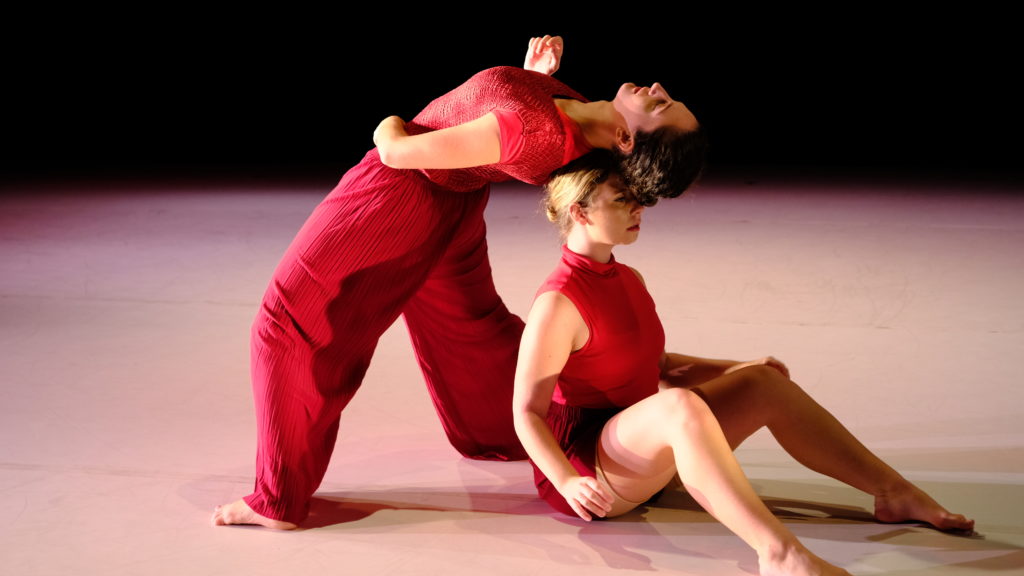
Courtesy of Lori Teague
You don’t go to a dance performance so the dancers can call out your earrings. Or your outfit choice. Or your seat selection. But this is exactly how Emory Dance Company’s (EDC) Fall showcase began. Held Nov. 21-23 in the intimate dance studio in the Schwartz Center for Performing Arts, the showcase blended styles and highlighted stylistic diversity in contemporary dance.
Students performed an array of new works, featuring choreography by Emory Dance professors and Israel Institute Visiting Artist Dafi Altabeb. Altabeb kicked off the showcase with “It’s Not A Pipe.” Inspired by surrealist painter Rene Magritte’s seminal painting “The Treachery of Images,” the work broke the fourth wall, pulling in audience members by directly addressing them. Just as Magritte’s infamous work challenges truth in painting, Altabeb challenged her dancers to be vulnerable and truthful with the audience.
Clad in campy, colorful costumes, the dancers stood in a triangular formation, staring straight into the audience. With the house lights still on, the performers launched into a chorus of criticisms. Repeating the phrase “It isn’t okay to,” the performers called out audience members by name or scolded each other for their positioning or misplaced cue. The effect was alarming; dancers in garish costumes berating their audience is an immediately provocative start to a performance.
Eventually, the dancers devolved into individual movements, some jumping and stomping around the stage, others twisting their limbs and convulsing on the floor. All the while, the criticisms continued, frustration rising among the performers. Finally, the performers cried out their emotions, pouring out and announcing personal and political frustrations with their identities, their relationships and the world around them.
Altabeb’s work was followed by “After Love,” choreographed by guest choreographer and Emory alumna Jessica Bertram (17C). Consisting of a series of duets, the dance explored the world of emotions in relationships. Dancers labored over one another, leaning on and collapsing under the heavy weight of each other’s bodies. Dancing to the sounds of the soulful Timmy Thomas song “Why Can’t We Live Together” and the atmospheric funk of Childish Gambino’s “Me and Your Mama,” the piece was a startling, often heartbreaking rumination on intimate human relationships.
“Sweet Suite,” choreographed by Emory Dance Instructor Krisitin O’Neal, featured a collection of short pieces set to sweeping 1950s pop and big-band music. Across each of the five selections, each performer crafted dynamic individual characters, imbuing their performances with personality and rich storytelling that covered a range of emotions.
A standout from the series was the final piece, titled “Nice Work, Grace!” In the most comedic performance of the night, two dancers attempted to complete their duet, stumbling and fumbling their way through the movements. With pitch-perfect comedic timing, the piece brought levity to the showcase and was well-received by the audience.
After a brief intermission, performers returned with choreographer Julio Medina’s (13C) “form & fragment.” The Emory Dance assistant professor and alumnus based the piece after the French philosophical concept of “actant,” understood to be “a source of action that can be human or nonhuman.” A sense of urgency permeated the piece, as dancers ran in circles around the stage or crawled hurridley toward the audience.
Although dressed in utilitarian black jumpsuits, the dancers blended a wide range of styles, dipping into hip-hop, contemporary dance and even pedestrian, everyday movements. In keeping with the theme of “actant,” mundane human actions like brushing teeth were distorted into stiff, synchronized routines.
Emory Dance Director and Associate Professor Lori Teague choreographed the closing piece, “The Optimistic Body.” Awash in cool blue lights and draped in ethereal, jewel-toned costumes, the finale was the most serene selection of the evening. Dancers filled the stage, often moving through the space en masse — a contrast to the highly individualistic previous works.
Teague explored themes of vulnerability and collectivity, probing “the relationship between optimism with realism.” Dancers moved across the stage with natural, fluid movements to a twinkling score by pianist Nils Frahm. Particular moments, like when a dancer carried another piggyback across the stage, dramatized Teague’s expression of optimism through recovery and reconciliation. The joint movements of their bodies underscored a theme of togetherness, transcending the physical to the metaphysical.
As a newbie to the contemporary dance scene, I found myself wholly transfixed by EDC’s Fall performance. With little background or deep knowledge of contemporary dance, I could still get wrapped up in the stories. By telling deeply human stories — of heartbreak, loss, camaraderie, unity and reconciliation — student performers welcomed everyone into the complex worlds crafted by dance.
The post Emory Dance Company Features Provoking, Vulnerable New Works appeared first on The Emory Wheel.
